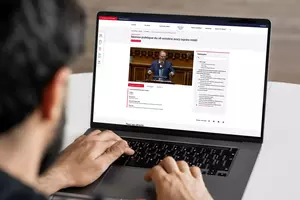III. A STRATEGIC COMPASS THAT HAS BECOME RISKY
It would be regrettable if the Strategic Compass were to be a failure, particularly for the CSDP. In matters of European security and defence, experience shows that disillusions can have a great impact and postpone any chance of progress for many years.
Under the previous American presidency, the Strategic Compass was a ray of hope. But the new international situation is not favourable : the US's return to multilateralism, the reaffirmation of NATO's protection, budget constraints, the risk of the Franco-German engine stalling... We might say that the Strategic Compass is losing its bearing. This could be, as we have seen, a way to orient it more to the west.
Ultimately, whilst the European Union seemed to have resolved to take on a true political role on the international scene, this exercise seems less an opportunity than a risk: that of encouraging the EU's strategy to take a step back next to--or even get behind--a revitalised NATO.
This risk is the result of various pitfalls that threaten the Strategic Compass. These can be listed as follows:
- a document emaciated as a consequence of the freefall in the greatest common denominator between a few countries, including France, with ever-strong ambitions and a group of countries that want to satisfy a United States that remains very reluctant on the issue of Europe's strategic autonomy,
- a more consistent document that actually reproduces the strategy of an all-powerful NATO that is firmly in line with its Strategic Concept ,
- a document with apparently stronger ambitions for the CSDP , but with reservations and that is so general that it could be unworkable ,
- a document with too much detail that risks being a straitjacket in a crisis .
These four pitfalls, which are not exclusive since the document will have several chapters, are made all the greater by a fifth, that of a France that intervenes too much during its presidency, alienating its partners and further reducing the chances of reaching a document that would allow the EU to make progress on its security and defence.
A. THE RISK OF AN UNAMBITIOUS DOCUMENT
At this stage, the threat assessment is just a simple compilation that has not been prioritised. When the time comes to adopt the Strategic Compass, the objectives and the resources put on the table will have to be ranked, and these threats will have to be weighted ahead of this. This work promises to be difficult. Already, the Polish and the Lithuanians, for example, never fail to remind us during EU Military Committee 90 ( * ) meetings that the threat assessment has not been adopted.
Since the new international situation has reduced most Member States' ambitions for the CSDP, the threat assessment that will be shared by all Member States could very well focus on the most recent ones , the hybrid and technological threats that are global challenges and the most consensual. Therefore, working from the idea that we must strengthen our capabilities in contested spaces and adjust how we act to address hybrid threats, the emphasis could be placed on the 'resilience' basket to the detriment of 'crisis management' , and on the capability component in its purely industrial and technological sense.
However, nearly two years will have been lost if the Compass does not show real progress for the CSDP . Indeed, many capability and operational instruments are already in place; very significant progress could be made almost immediately by supporting increased power for some--the EDF has great potential with 42 PESCO projects--and improving how the others function by taking inspiration from existing assessments. It would be a clear failure if, for example, the Compass simply reiterated the recommendations of the November 2020 CARD.
Then, this lack of ambition could unfortunately last, since it would in some way be made official by a long-term document presented as binding on all Member States. This risk especially concerns the CSDP in its military dimension, the most decisive over the long run to preserving Europe's ability to take action.
Here, an adjacent risk is that the Strategic Compass partially saves face by including binding initiatives to improve civil missions and, perhaps, non-executive military missions, in line with Germany's approach.
* 90 The highest military body set up within the Council. It brings together the 27's Chiefs of Staff; its president is Italian General Graziano, who advises the HR/VP at the EEAS.







